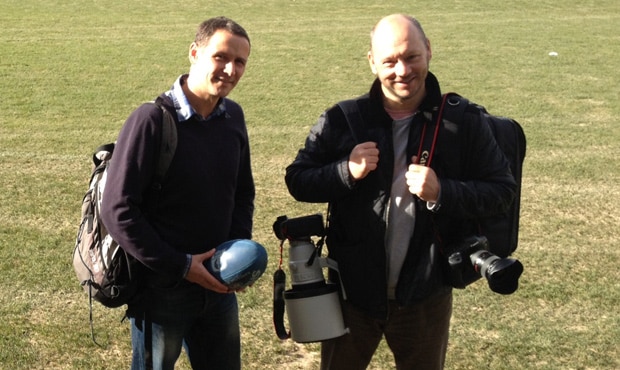A tick over 125 years ago to the day, on the hallowed turf of the Melbourne Cricket Ground, these same men emerged victorious in a match of Australian rules involving the British and Irish Lions’ inaugural touring party.
The pages of this long-forgotten chapter of colonial football history were dusted off and turned again this week, when today’s British and Irish Lions jetted into Melbourne for Saturday’s much-anticipated Second Test against the Wallabies. Flicking the pages was visiting sports journalist for The Times in London John Westerby who, together with photographer Marc Aspland, also lobbed to cover the latest phase of the Lions’ national tour.
Earlier today, Westerby and Aspland paid Visy Park a visit to view a Carlton training session, immerse themselves with that quaint little game called Australian Rules and reflect on that historic expedition of 1888.
“The British and Irish Lions tour is all about the history. It’s steeped in tradition which is all the more refreshing thesedays with professional sport all the more commercial,” Westerby said.
“The players tap into that and the tour means a lot to them. That prompted me to look into the history of the British and Irish Lions and look in to the first tour . . . and I was amazed to find that on that inaugural tour they played almost as many games of Victorian rules as they did rugby . . . and would you believe that the first game of rules that they played was against Carlton.”
Westerby said that the tourists’ thoughts had turned to AFL given the stunning exploits of Israel Folau at Suncorp Stadium last Saturday night “because that cross-over in codes doesn’t happen very often does it”.
“Coming into Melbourne, I wanted to know a little more about Australian Rules and to find out where members of that inaugural touring party had been, and as luck would have it I found my way here,” Westerby said.
“I work across a range of sports back home, then main ones being rugby union and cricket both of which carry a keen sense of history, and it’s lovely to come to a club like Carlton which is so very proud of its heritage.”
A 21-man Lions squad, which included players from England, Scotland and Wales, committed to what was surely an exhaustive 35-match tour of New Zealand and Australia in 1888. Though no Tests were played, union matches were staged against provincial, city and academic teams and although the tour was unsanctioned by union’s governing bodies, the concept of Northern Hemisphere sporting sides touring the Southern hemisphere was established.
The touring Lions also participated in exhibition matches of Australian Rules against Victorian teams Essendon, Fitzroy, South Melbourne and of course Carlton, as well as the South Australian teams of Adelaide, Norwood, Port Adelaide and South Adelaide.
Westerby believed that the English entrepreneurs unashamedly saw the maiden tour to the Antipodes as a means of making money, and are to be commended for their sheer ingenuity in dealing with the logistics. As he said: “The Lions played something like 19 games of Australian rules, travelling all around Australia by horse and cart”.

John Westerby (left) and Marc Aspland at Visy Park. (Photo: Carlton Football Club)
The maiden British tour was an entrepreneurial triumph for the famed English cricketers AE Stoddart, Alfred Shaw (who bowled the first ball in Test cricket), Arthur Shrewsbury and James Lillywhite, England’s first Test captain.
As for the Carlton match - Saturday, June 16, 1888 - the home team so capably led by the captain Tommy Leydin emerged comfortable victors. So it’s perhaps best that the final word should belong to The Argus correspondent of the day.
“An immense crowd assembled on the Melbourne Cricket Ground on Saturday afternoon to watch the match between the English Footballers and the crack Carlton team. Fully 25,000 persons thronged the ground,” the writer noted.
“From the start it was evident the Englishmen did not understand the game, and the result was that the Carlton simply did what they liked with them. When time was called for the last quarter, Carlton had scored 14 goals and 17 behinds to 3 goals and 7 behinds on the part of the English team.”


